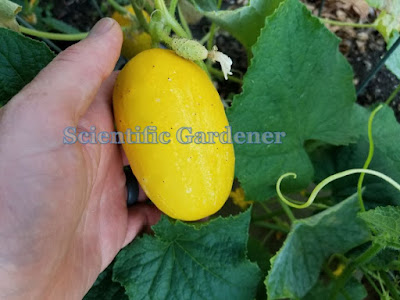While I was not able to harvest any native creeping cucumbers from a relative’s home in Louisiana in 2021, I was able to acquire some seeds of the creeping cucumber (Melothria pendula) for a trial growout in the summer of 2022.



After harvesting a couple of pounds of seed of the cucamelon or Sandita (Mexican Sour Gherkin) back in 2020, my wife had me promise to not grow or save seed of another cucamelon for all of 2021. The primary reason was that the time required to save the seed was so great that the time required took from the needs of our family. Being the wise husband that I am and knowing that the creeping cucumber is in the same Melothria family, I decided not to grow any cucamelon for all of 2021. Then in 2022, I decided to only grow a few creeping cucumber plants.



The vines themselves look exactly like the Melothria scabra, or Cucamelon. Additionally, the fruit themselves looked a lot like the light-green cucamelon fruit. While I was tempted to ask the seller about possibly giving me the wrong variety, I decided to be patient.



In a short amount of time, I began seeing the fruit turn from being light to dark green to nearly black. When the skin has fully darkened, consuming the small fruit is supposed to be a highly effective purgative. While this can be helpful (in small quantities) for those of us having difficulty digesting, eating these fruit can be dangerous for dogs or other pets or even young children. In contrast, neither light nor dark fruit deterred the squirrels from consuming them, as they would gladly snack on them on their way across the fence.



The taste and texture of the creeping cucumber are very similar to the regular cucamelon. They have a generally firm texture – from rind to inner pulp, a flavor reminiscent of cucumber rind, and a bit of a intriguing texture with a slightly acidic aftertaste.



One thing that really sets the creeping cucumber apart from the Cucamelon is the vine’s tendency to re-root. The plant readily reroots along the ground at any internode that is low enough to send roots down. While this is a fantastic survival strategy in the wild, the rerooting, along with how easily the seedy fruit drops below the foliage this vegetable can become very invasive. My previous experience with the cucamelons was that they can continue to sprout out of the ground for many years to come. Additionally, I have read that – in areas without frost – these fruiting vines can be perennial.



So – if you experience concerns about your effectiveness as a gardener, growing the creeping cucumber will provide a boost of confidence. Especially in a mild climate, creeping cucumbers are the garden plant that you will not just avoid killing, but – once established – may be difficult to get rid of.



In summary, the Creeping Cucumber is very much like a Mexican Sour Gherkin, but with the purgative effects in the older fruit and increased rooting tendencies.














































